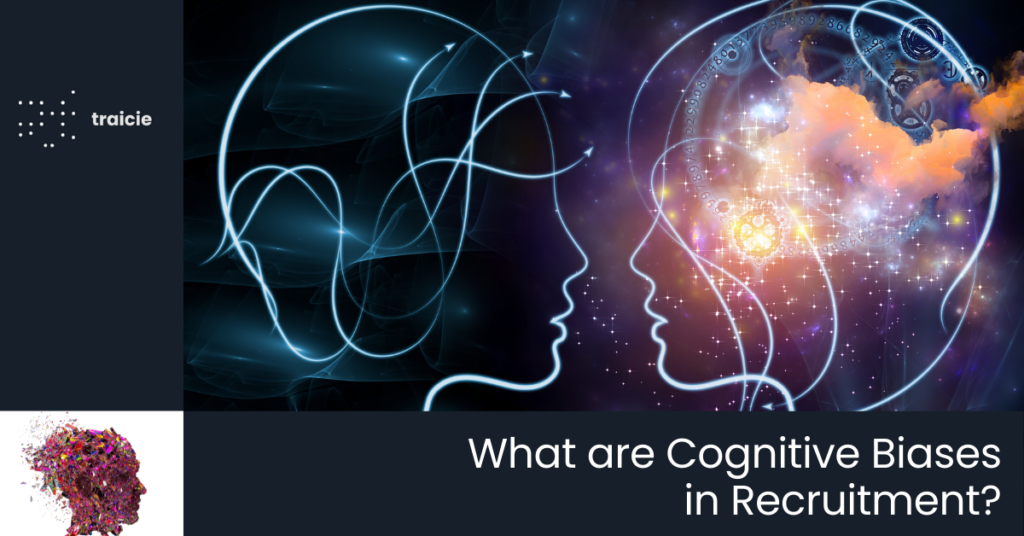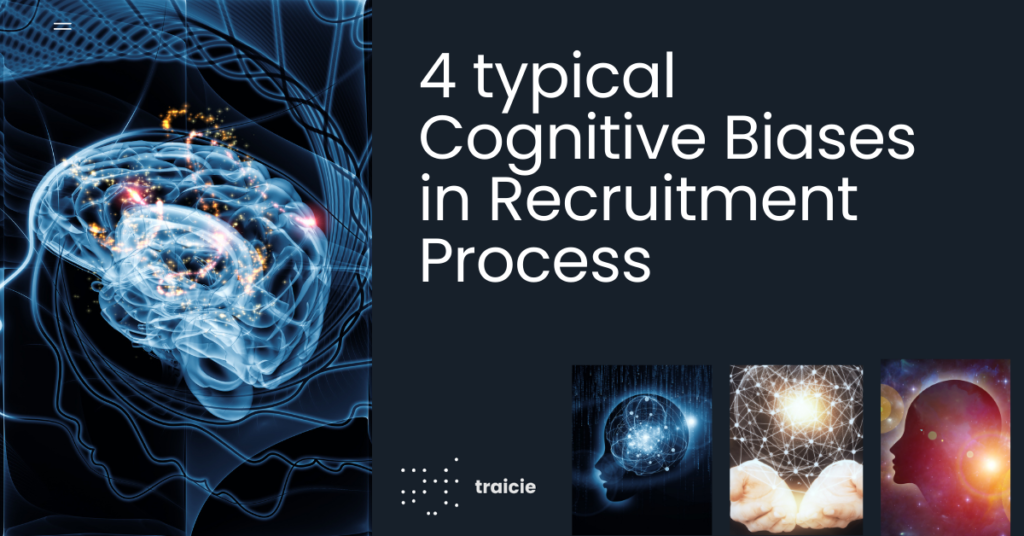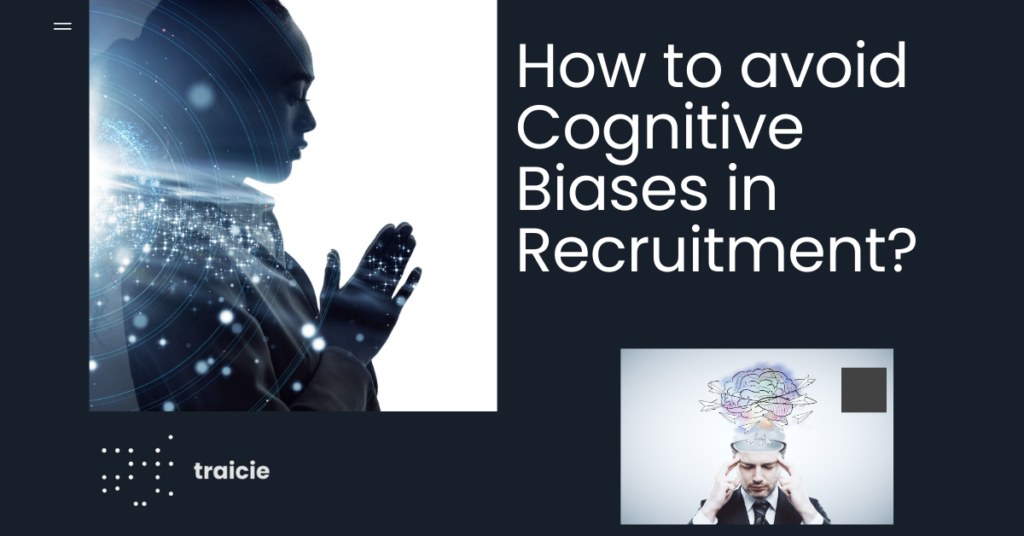We all know that Cognitive Biases in Recruitment are Harming Your Hiring Process, but do you know which ones to watch out for?
A group of NYU students reported in 2015 that 75% of recruiters decide within the first 16 minutes. Even within the first three minutes, 25% of interviewers made a decision. As a result, the candidate’s fate will already be determined after sharing only a fifth (or less) of who they are and what they are capable of. Anyone can make mistakes when interviewing due to cognitive biases. In this article, we will find out what cognitive biases recruiters may encounter and how to avoid them as much as possible.
What are Cognitive Biases in Recruitment?
American psychologists Amos Tversky and Daniel Kahneman introduced the term “cognitive bias” in 1970. Cognitive bias is a systemic inaccuracy in perception that occurs as people absorb and evaluate data from their environment. This inaccuracy has an impact on their conclusions and judgments. These specialists contend that this type of bias can skew our judgment since they foster bad decision-making by adopting shortcuts.

Although sophisticated, the human brain has its limits. The brain tries to make the processing of information as simple as possible, which frequently results in cognitive bias. These deceptive thought processes most frequently surface in situations where there is a wealth of data, like during hiring. Identifying them is the key to avoiding them.
| >>> Find out: the solution of AI in HR: How does it eliminate hiring bias? benefits and limitations.
4 typical Cognitive Biases in Recruitment
Here, we would like to explore and explain the 4 major Biases in the recruitment process.
- The Halo Effect
- The Horn Effect
- Confirmation Bias
- Affect Heuristic Bias
1. The Halo Effect
The most prevalent Cognitive Biases in Recruitment that arise during any hiring process is known as the “Halo effect”. Here a single favorable attribute or characteristic of the interviewee affects the evaluation of other unrelated characteristics.
This is the propensity to feel strongly about everything a person has, even for qualities you haven’t examined or assessed. Because of confirmation bias, you assume there is proof even though there may not be any because you expect to see (or not see) anything.
| >>> You might also wonder about: Recruitment funnel: how to optimize your funnel by creating the right metrics?
Sometimes, people assume that if someone is gorgeous, he is also smart, nice, and humorous. This one clear favorable characteristic acts as a “halo,” leading others to believe untrue things about their personalities or ability. This is often referred to as the “physical attractiveness stereotype,” in which our perception of a person as a whole affects how we feel or think about their morals.

Need more help?
This occurs frequently in the employment process when an interview is going well. The hiring manager may overlook a crucial component of the evaluation process because they believe the candidate already possesses the necessary skills in other areas.
Do you know that traicie can help you to reduce bias in Hiring Process Effectively?
For instance, while analyzing applications, a hiring manager may think that an applicant who attended a prominent university must be a wonderful fit for their business, regardless of the candidate’s knowledge, skills, and attitude. Not taking into account that the other applicants might be a better fit with their ideal candidate profile although they are graduates of other, conventional, universities.
2. The Horn Effect
The polar opposite of the Halo effect is known as the Horn effect. The horn effect occurs when individuals think undesirable characteristics are related. We subconsciously sigh a little and think, “This is going to be a long hour,” when a contender fumbles with the opening question.
We already have the predisposition to favour the politician as we pose the second question. The existence of an unattractive characteristic of a person from the observer’s perspective might harm how others perceive that person.
| >>> Read more: The Employee Life Cycle Model: what is it and why it is important?
The Horn effect makes a recruiter place a great deal of focus on even just one adversely evaluated quality, remark, or action. The candidates risk not being considered by portraying whatever the recruiter considers as a poor feature, as a result of these Cognitive Biases in Recruitment.
3. Confirmation Bias
Confirmation bias is; the desire to seek out or interpret information that supports one’s own opinions. This kind of unconscious, unintended bias in judgment frequently leads to the disregard of contradictory facts and is the most common one of the Cognitive Biases in Recruitment.
Confirmation bias describes our tendency to prioritize information that supports our current ideas. This affects the data we collect, analyze, and remember. As a result, rather than learning more during an interview, you tend to rely on your first impression and look for evidence.
Confirmation bias occurs when a recruiter gets an initial impression of a candidate and then searches for and concentrates on data that confirms that impression. This includes ignoring warning signs that oppose their opinion and asking unnecessary, unimportant interview questions that validate their opinions.
| >>> Update: 70+ Recruiting Statistics and Effective Hiring Trends in 2022
Specifically
Within 13 minutes of meeting a candidate, 75% of interviewers will decide on their suitability. The danger is that we can be overlooking some excellent prospects without even realizing it.
Consider a scenario in which the recruiting manager has two excellent candidates—a man and a woman—for a managerial post. The interviewer, however, thinks that men make better executives by nature than women. Because of this, the recruiting manager might hunt for evidence to support his preexisting bias. This can make him ignore the data suggesting that the female applicant might meet the ideal candidate profile better than the male applicant.
Peer recommendations and viewpoints can occasionally cause “confirmation bias”. If one of the recruiting manager’s coworkers makes a recommendation and influences him, there will undoubtedly be confirmation bias – a Cognitive Bias in the hiring process – at play during the interview, where the interviewer will look for any opportunity to hire that individual while ignoring other viable prospects.
4. Affect Heuristic Bias
The affect heuristic bias is a cognitive flaw that causes people to make judgments that are substantially influenced by their feelings at the time. Heuristic bias has the effect of making insignificant factors contribute to our decisions.
When making a hiring decision, a candidate’s risks and advantages may be evaluated based on how quickly specific aspects of them evoke an emotional response.
Interviewers will react emotionally quickly and favourably if they recognize an applicant as being from the same school or college they studied at, the same location where they were born or resided or the same community they belong to. The recruiter will quickly determine that they like the candidate and spend the rest of the conversation riding that early, emotional wave of enthusiasm.
Other prejudices that sparkle Cognitive Biases in Recruitment throughout the recruiting process include those based on; gender, intuition, affinity, anchoring, attention, and difference. We will discuss these in more detail in a later post.
How to avoid Cognitive Biases in Recruitment?
Wait and Retry
“Wait and Retry” is a good interview strategy to combat the effects of Cognitive Biases. This method enables the deliberate and consistent control of judgment that distinguishes excellent interviewers.
Try to suspend your first judgment so that you don’t stick to your initial thoughts. Allow each applicant the opportunity to show themselves, putting aside your preconceived notions. The strategy may appear counter-intuitive initially. However, it would be unfortunate if there are prejudiced interviewers due to a rushed and possibly incorrect conclusion!
| >>> Do you know that: Augmented Recruitment can reduce bias but at the same time source 23% more talent in 37% less time
After the interview, time to make the recruitment choice. Although it seems apparent, this does not always occur. Instead, people start to generate an impression about an applicant, unconsciously, as soon as they enter the room. This phenomenon starts, even before the interview, when you look over their cv, this might begin.
More tips
Some profiles inherently appeal to us more than others. But during the interview, you shouldn’t let the candidate’s resume color your opinion of them. It should only affect the concerns you pose, the results of which you will then evaluate.
Therefore, the first stage is consciously realizing that you are already passing judgment before anyone has even spoken, followed by a cognitive reset to normal. With every single inquiry, the recruiter might maintain this “holding” of judicial practice.

Do not let a candidate’s response to a question lead you to establish an opinion about them, regardless of how well they answered. Each response must be evaluated as a separate, abstract event.
This is more difficult than it first appears because you must distinguish between your current evaluation of each response and your final evaluation of the candidate. Keep in mind that each question is just one of many data points. You will evaluate the applicant using all of the responses. However, you are merely gathering information during the interview to support a later judgment.
“Retry” patiently
You need to “retry” frequently to do this. You will have an opinion on the calibre of each response, after each inquiry. That’s great to expect. However, your evaluation of the subsequent topic must stay separate from your evaluation of the prior question. Restarting enables the applicant to answer each question from scratch.
Restarting practices stops a trajectory that results in rash decisions. It combats the horn and halo effects. It assists you to avoid fixating on a particular response and prevents you from verifying what you already believe to be true.
Specifically
Biases have a simple way of taking control of your decision-making. They have the power to manipulate you without your knowledge, leaving you to wonder why your hiring procedure continues to yield inconsistent outcomes.
| Start to identify the weaknesses | Avoid hiring errors by carefully considering what typically transpires in our brains during an interview. You can do far better than a 50% success rate when it involves recruiting talent. You can diversify your company even more. To do that, you must take the time to comprehend how your brain generates choices, the effects of bias, and most crucially, how to enhance these judgments, which significantly influence your company’s performance. |
| Ask an open-ended question rather than narrowly targeted ones | Ask candidates to describe instances where they have to show a strong sense of organization rather than asking if they are organized. If transparency and strong interpersonal skills are among the qualities, you are looking for in a candidate. Ask the applicant to describe a time when they gave their supervisor honest feedback |
| Examine the variables that affect your choices | Make intelligent decisions by considering the past factors that influenced your choices. Do they include something like arrogance or self-interest? |
| Maintain a flexible mindset and promote creative thinking! | Consider the applicant’s soft skills and the intangibles that don’t usually appear on the resume. The “perfect profile” applicant may not always be the best. There is more to a job than just a checkbox list of requirements. |
| Fight your prejudices | If you discover that certain aspects drive your decisions, concentrate on actively fighting your biases. |
| What are some of the elements you missed? Do you place too much emphasis on some variables? | Do you disregard pertinent information because it contradicts your opinion? You can become a more critical thinker by considering these issues and confronting your prejudices. |
Conclusion
Several factors are taken into account while hiring new employees. The capacity to perform the job properly should be the primary factor when hiring a candidate. Even while hiring managers try to limit their decisions to the information presented and behaviour demonstrated by candidates, sometimes decisions are made based on unfavourable outside circumstances.
Most of the problems will be resolved if we recognize that those facts represent specific types of Cognitive Biases in Recruitment and their influences on hiring. The success and expansion of any firm will profit from our meticulous recognition and selection of the ideal candidate. The hiring and development of individuals are more crucial than everything else we do. In the end, you stake your bets on people rather than tactics.
Do you know that traicie sourcing tools for recruiters can help the Hiring Team not just to eliminate Cognitive Biases in Recruitment but also in the strategic, operational value of the recruiting process:
- Cost of a job board – Reduce annual spending on job boards
- Cost of HR tools – Reduce the cost of surveys and assessment tools
- Recruitment costs – Reduce selection costs
- Internal mobility – Fill more skilled jobs with internal staff
- Time to hire – Reduce the number of days a role goes unfilled
- Salary costs – Reduce overall salary costs
- Attrition – Reduce the rate of turnover
- Recruitment cost – Reduce the general recruitment cost
5 thoughts on “Cognitive Biases in Recruitment Process, How to avoid it?”